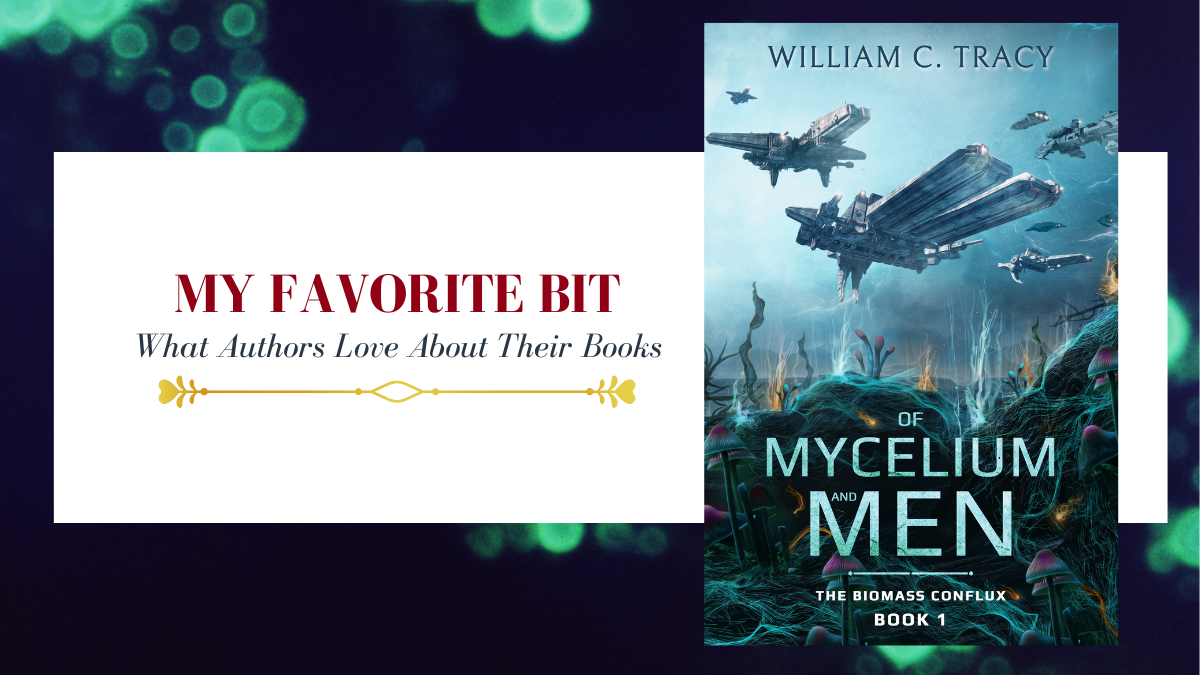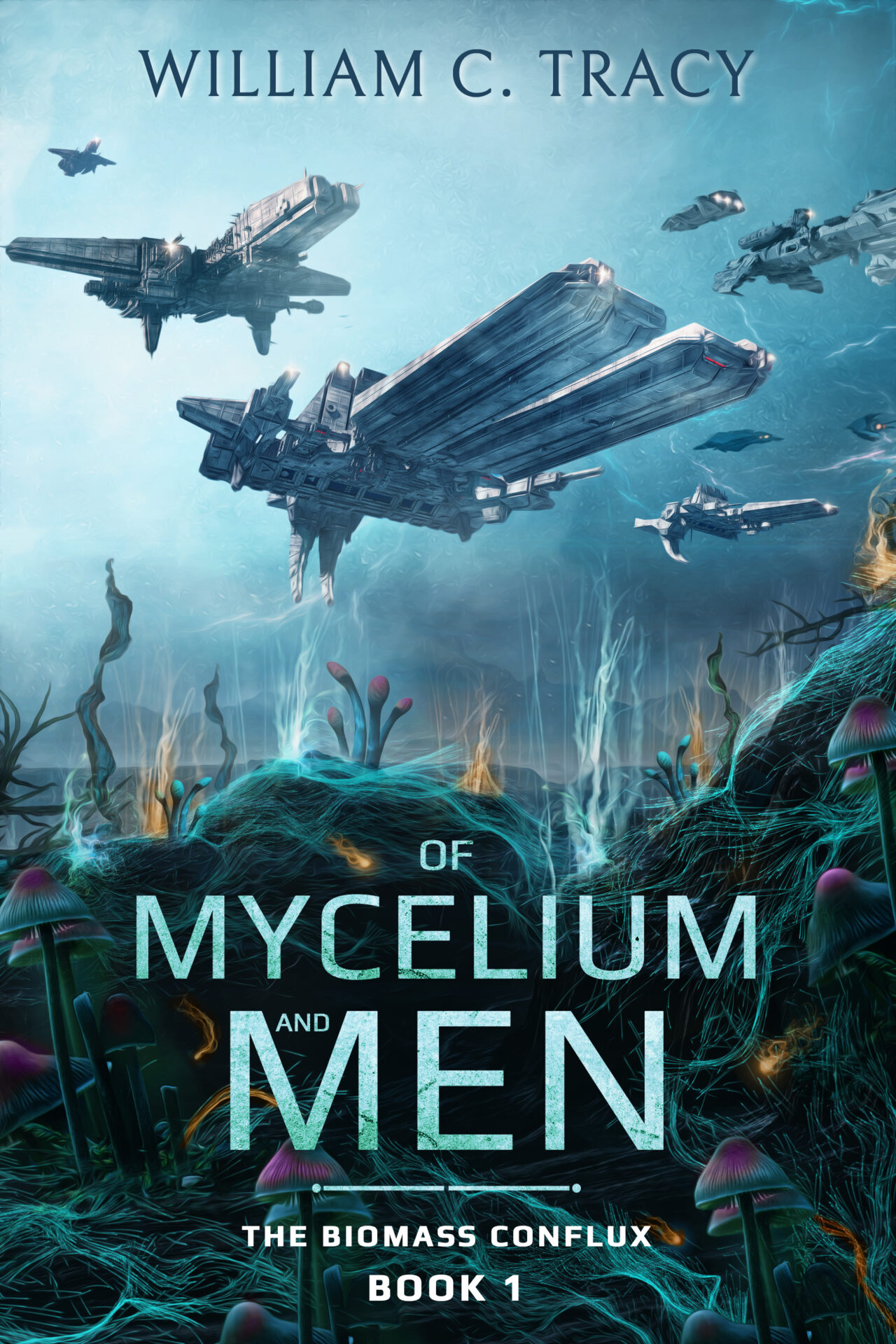
William C. Tracy is joining us today to talk about his novel, Of Mycelium and Men. Here’s the publisher’s description:
The generational fleet planned to make landfall after eighty years, but eleven planets and four centuries later, they still had not found a home. Finally, they landed on Lida, but something already lives there, and it’s big.
Agetha and her husband have spent their whole lives in the fleet’s zero-G. Now all is turmoil as the fleet lands, discovering they are surrounded by a single fungal biomass spanning the entire planet. To build a new home, the fleet must confront a dangerous organism, and Agetha must decide if she can raise a family in this inhospitable landscape.
Jane Brighton holds tenuous command over the colony and its administrators. She and the other gene-modded leaders emerged from their four-hundred-year suspended animation to find a crew much different from the one that departed Old Earth. Jane must direct the colony’s fragile growth and defend it against being overrun by the fast-growing biomass.
But there is something none of the colonists know. The massive organism that spans the planet is not simply a fungal mass, nor even a chimerical combination of species that once roamed the planet. The biomass has desires and goals, and one is to know these strange beings carving out a home in its midst.
What’s William’s favorite bit?

WILLIAM C. TRACY
One of my favorite parts of research on this book was getting things wrong. The idea for a planet of mushrooms started out many years ago with a discussion on Hatteras Beach in North Carolina about how weird mushrooms and fungus are. Some friends and I talked about how they can get into your system and stay there for years, and how they can do anything from taste delicious, to affect your nervous system, to make you high, or kill you.
So naturally I wrote a book about it, with a planet-wide sentient fungus as a character. It has no concept of self, so I wrote its POV in passive voice, which was itself a kind of catharsis after training myself for so many years to write in active voice. It exists as a networked intelligence, in part made up from the instincts and personalities of the plants, animals, and likely even sentients that it has subsumed into its being over thousands of years. It has a childlike sense of wonder, though backed up by an entire biosphere of nature, red in tooth and claw (and spine and cell and spore and root). I plan to dig into its personality even more in the second and third books.
Add to this a generational ship filled with people who’d hardly ever seen gravity, and I had some cool aspects to work with. I began to document the chronicle of a generational fleet making landfall and carving out a colony on this fungus-covered planet. I wanted things to get weird, like the conversation I’d had about mushrooms, but I kept being stymied by science.
My main critique partner is also a mycologist, so every time I tried to come up with some cool thing this fungus could do to the colonists, I’d get feedback like “no, fungus already does this,” or “coming up with an entirely new method of reproduction is not a big deal for fungus,” or “why do you want to include fungal animals? Fungus is already a lot more adaptive than animals are.”
It was frustrating to weave my story around how incredible and varied fungal life is, but it was also a really great opportunity to come up with even better ideas to pose as challenges for the colonists. Here’s one of my favorite early parts, when one of the scientists, Frank Silver, discovers just how extensive the fungus is:
“You’ve seen my research on the cell walls? We saw this in the original samples taken by probes. What I would have termed animal, plant, and fungal cells on Earth are all jumbled together here. My hypothesis is the viral strains transiting between the three types of cells pass information between them rather than disease. The physical samples look like hyphae—” He looked squarely at her, and Jane barely kept from gritting her teeth. “See, what you call mushrooms are just the fruiting bodies of the mycelium, and the mycelium is made of stringy things we call hyphae. Those are the long connective strings that make up fungus. So, the samples look like hyphae at the surface level, but the larger products combine into completely unique mycelium, depending on the situation. Those animals and plants out there? They’re just really weird fruiting bod…I mean mushrooms. They’re really weird mushrooms.”
And a little later on in that same scene:
“…I matched DNA sequences from the river, the cavern, and the edge of the colony. These places are separated by kilometers. The DNA matched exactly. Not to eighty or eighty-five percent, but one hundred percent. No drift, no changes. Even single spore growth in a Petri dish has some amount of drift.”
“Surely there are random harmless mutations,” Rajani said.
Silver waggled his forefinger in the air. “That’s what I assumed. If there are, they are the same mutations in all the samples. All of them.”
Rajani sat back, blinking.
Jane was getting tired of all this scientific babble. “So, they’re the same species. What about it?”
“No, not just the same species,” Silver corrected her. Jane lifted her chin, but let him continue. “The same. As if you met a clone of yourself, but not even that. As if your clone had lived your same life, encountered the same stimuli, had the same scars. The weird fungal towers at the edge of the wild growth outside the city are the exact same organism as the mushrooms spitting winged things in the caverns and the floating blobby organisms on the river.”
…
“You’re saying the entire…biomass…covering this planet is one organism?” Jane said. “In the oceans? On land? The towers and the creatures, and mushrooms, and everything?”
“I suspect so,” Silver answered.
I’ll note that several parts of this section were, ah, corrected by my mycologist friend. I was trying to make a cool alien fungus, but I wasn’t even capturing all the weirdness of terrestrial fungus!
After many discussions back and forth about mycology, I think I’ve got a story that does justice to how weird mushrooms can be. So, when you read Of Mycelium and Men, know that I wouldn’t be surprised if something like the biomass exists out there somewhere. For now, I’m going to have a lot of fun with the repercussions of all this mycelial strangeness while writing books two and three!
LINKS:
Of Mycelium and Men Universal Book Link
BIO:
William C. Tracy writes and publishes queer science fiction and fantasy through his indie press Space Wizard Science Fantasy, which is open to submissions (spacewizardsciencefantasy.com). He is an NC native and a lifelong fan of science fiction and fantasy. He has a master’s in mechanical engineering, and has both designed and operated heavy construction machinery. He has also trained in Wado-Ryu karate since 2003 and runs his own dojo in Raleigh, NC. He is an avid video and board gamer, a beekeeper, a reader, and of course, a writer.
